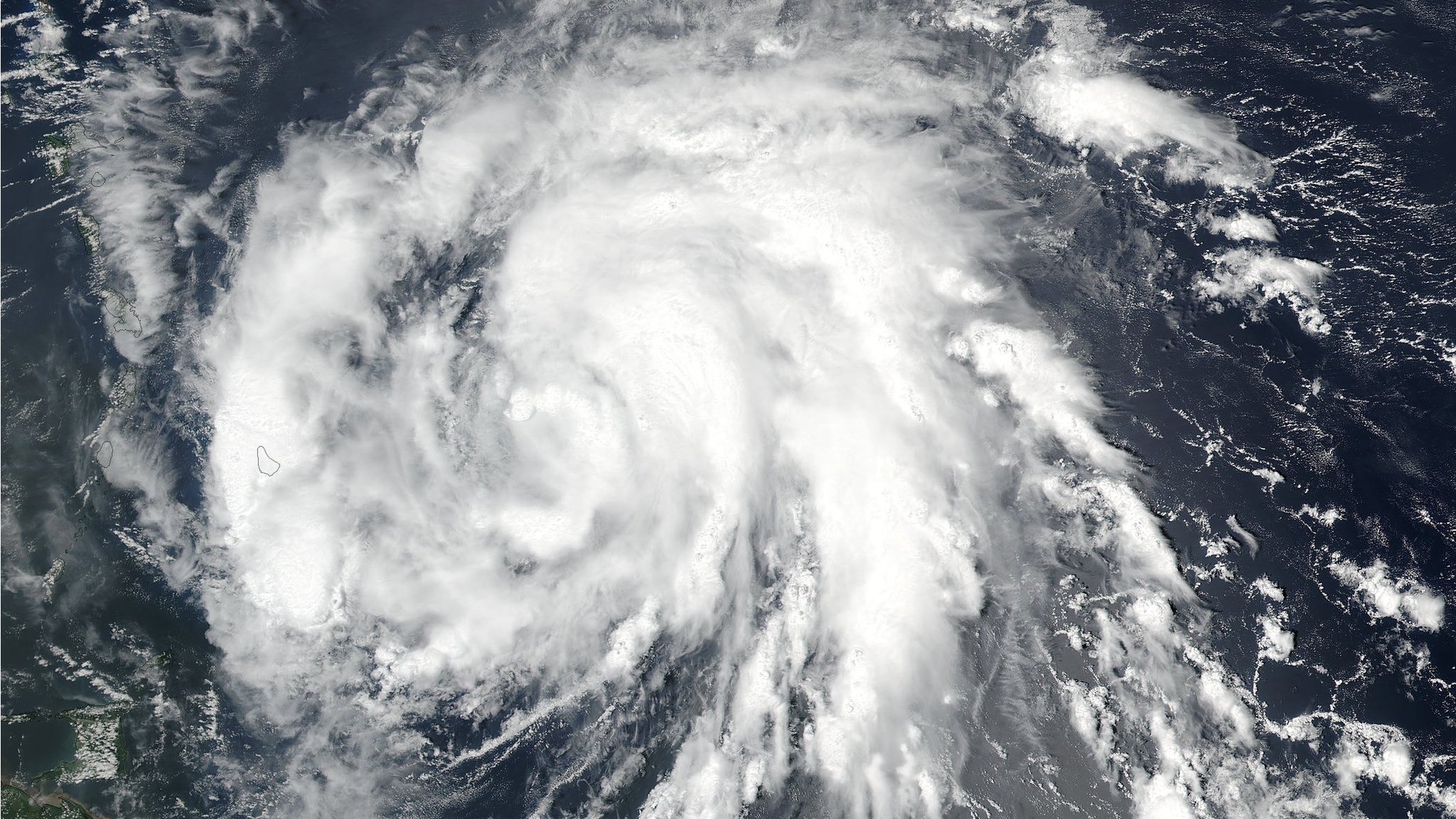
Hurricane Maria is expected to strengthen further as it nears the Leeward Islands in the Caribbean.
It has been upgraded to a category two hurricane, and is forecast to hit the islands late on Monday, the US National Hurricane Center (NHC) says.
It is moving roughly along the same path as Irma, the hurricane that devastated the region this month.
Hurricane warnings have been issued for Guadeloupe, Dominica, St Kitts and Nevis, Montserrat and Martinique.
A hurricane watch is now in effect for Puerto Rico, the US and British Virgin Islands, St Martin, St Barts, Saba, St Eustatius and Anguilla.
Some of these islands are still recovering after being hit by Irma – a category five hurricane which left at least 37 people dead and caused billions of dollars’ worth of damage.
In its latest update on Monday, the NHC said that Maria had maximum sustained winds of 175 km/h (110mph).
The eye of the storm is 100 miles east of Martinique, and Maria is moving west-northwest at about 13mph.
“Preparations to protect life and property should be rushed to completion,” the NHC said.
The centre said it expected Maria to grow into a “major” category three hurricane later on Monday.
In the French territory of Guadeloupe, schools, businesses and government buildings have all been closed and severe flooding is predicted in low-lying parts of the islands.
Preparations have also begun in Puerto Rico, where Maria is expected to bring strong winds on Tuesday.
The most southerly point of the Leeward Islands – where Maria will first strike – includes Antigua and Barbuda. The latter island was evacuated after being devastated by Irma.
The NHC says that “a dangerous storm surge accompanied by large and destructive waves will raise water levels by as much as 1.5-2.1m (5-7ft) above normal tide levels near where the centre of Maria moves across the Leeward Islands”.
It also forecasts a maximum potential rainfall of 51cm (20in) in some areas of the central and southern Leeward Islands – including Puerto Rico and the US and British Virgin Islands – through to Wednesday night.
“Rainfall on all of these islands could cause life-threatening flash floods and mudslides,” it warned.
Drone footage of Saint-Martin after Irma
Earlier this month, Irma left more than two-thirds of homes on the Dutch side of the island of St Martin (known as Sint Maarten) uninhabitable, with no electricity, gas or drinking water.
The French government has said its side of St Martin – known as Saint-Martin – sustained about €1.2bn ($1.44bn; £1.1bn) in damage, with nine deaths across Saint-Martin and nearby St Barts.

Media playback is unsupported on your device
On the British Virgin Islands, entire neighbourhoods were flattened.
After a visit to the area, British Foreign Secretary Boris Johnson described the damage as something “you see in images from the First World War”.
In pictures: Irma devastates British Virgin Islands
Virgin boss Richard Branson, who has a home in the Virgin Islands, has been tweeting ahead of the Maria’s predicted arrival, warning people to stay safe.
The Puerto Rican government has issued a statement saying it expects the hurricane to make landfall there as a category three on Tuesday.
The US territory escaped the worst of the damage from Irma – although it experienced widespread power cuts – and it has been an important hub for getting relief to islands that were more badly affected.
“Puerto Rico is our lifeline,” Judson Burdon, a resident of Anguilla, told Reuters news agency. “We had two volunteer flights cancel because of the weather that is coming.”
Irma also hit the US, with 11 deaths being linked to the hurricane. Nearly 6.9 million homes were left without power in Florida, Georgia, North Carolina, South Carolina and Alabama.
A second hurricane, Jose, is also active in the Atlantic, with maximum sustained winds of 90mph.
The centre of the storm was about 335 miles south-east of Cape Hatteras in North Carolina, the NHC said in its advisory at 21:00 GMT on Sunday.
Tropical storm watches have been issued for parts of the north-eastern US.
Are you in an area that is braced for Hurricane Maria? If it’s safe to do so, you can share your experience by emailing haveyoursay@bbc.co.uk.
Please include a contact number if you are willing to speak to a BBC journalist. You can also contact us in the following ways:
- WhatsApp: +44 7555 173285
- Send pictures/video to yourpics@bbc.co.uk
- Upload your pictures / video here
- Tweet: @BBC_HaveYourSay
- Text an SMS or MMS to 61124 (UK) or +44 7624 800 100 (international)
Note: This story is auto-generated from BBC syndicated feed and has not been edited by AFRICA PRIME NEWS